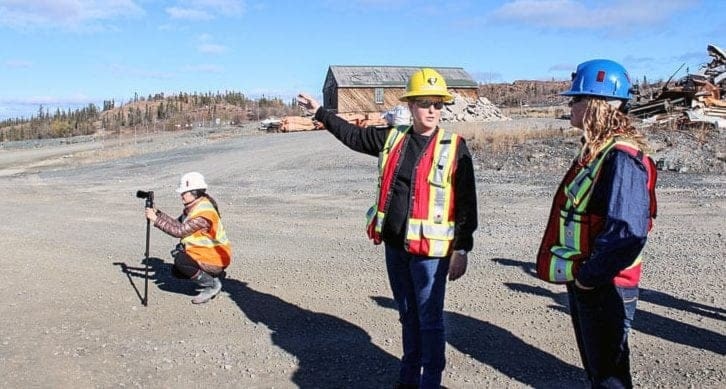The most conspicuous relic of Giant Mine was useless for most of the mine's roughly 50-year lifespan.
That massive structure with rust- and sallow-tinted silos that looms above the cliffs over Back Bay was a tailings reprocessing plant, says Natalie Plato, deputy director of the Giant Mine Remediation Project.
It was also an engineering “failure.”
Plato, who led media on a tour of the abandoned mine site last Friday, said she was told the plant was built in the 1980s and used Australian technology, which simply did not function in Yellowknife's subarctic climate.
The plant operated for about 18 months. Little else is known about the structure.
When remediation of Giant Mine begins in earnest, the plant, along with every other standing structure on site, will be torn down, buried underground or hauled away.
The clean up of Giant is a massive undertaking, almost incomprehensible in scope.
It involves: freezing 237,000 tonnes of highly-toxic arseinc trioxide dust in underground chambers; pumping and treating vast quantities of contaminated water; stabilizing mined-out cavities the size of office towers; filling open pits; relocating and covering tailings ponds; and disposing of all mining materials on site, including the infamous roaster complex.
In 2007, the remediation project was estimated to cost $934 million.

That figure will be updated in the next two years, but the team does not expect it to rise significantly.
Giant Mine produced gold from 1948 until 1999, when owner Royal Oak went bankrupt and responsibility for the mine was transferred to the government of Canada.
During the mine's operation, gold was extracted by cooking rock at extremely high temperatures.
This roasting process released highly-toxic arsenic trioxide dust, the byproduct that today presents a major problem for the federal government.
The Giant Mine Remediation Project team, which is co-managed by the department of Crown-Indigenous Relations and Northern Affairs Canada and the GNWT, has been tasked with addressing that problem.
This means containing the arsenic dust, cleaning up the mine's surface, and monitoring the site for up to 100 years.
Though remediation has yet to begin, the site is being worked on around the clock, 365 days of the year.
Mostly, this care and maintenance work consists of pumping water out from underneath the arsenic chambers, stabilizing underground voids and open pits, and regular monitoring of water, dust, air quality and wildlife.
To protect some of the mined out chambers from collapsing, the team is filling them with a paste made of tailings mixed with a cement product.
“We also keep the site secure 24/7,” said Plato.
“We have 24-hour security that patrols the site looking for wildlife and/or unwanted visitors.”
The project team is preparing to submit a water license to the Mackenzie Valley Land and Water Board. Once the license is granted, full remediation can begin.
Most notably, this will involve freezing the underground chambers containing the arsenic trioxide dust to keep out moisture.
The chambers will be kept at -5 C using a passive thermosyphon system that will draw out heat and using little energy.
Clean up of the mine is expected to begin in mid-2020 at the earliest, and continue until around 2030.
At the remediation project's peak, which is expected to last six to eight years, between 200 and 300 workers will be employed at the site.
The remediation team is aiming to hire northern and Indigenous workers, but has not yet set specific targets.
Monitoring at the site will continue for up to 100 years.
In the meantime, the Giant Mine Oversight Body, the independent agency overseeing Giant Mine's clean up, is researching a “permanent solution” to the arsenic trioxide dust problem, said Plato. “Something that is not just freezing it.”
